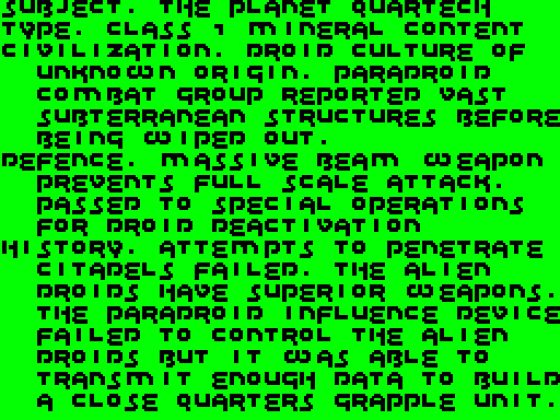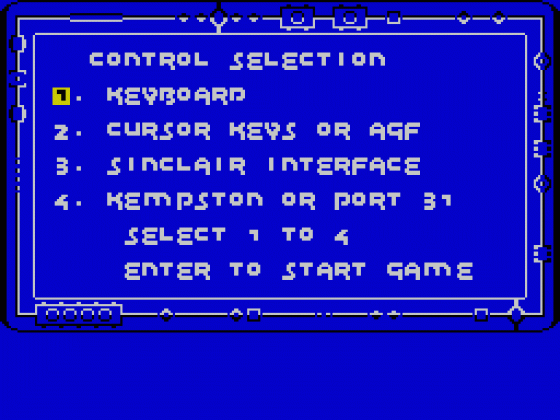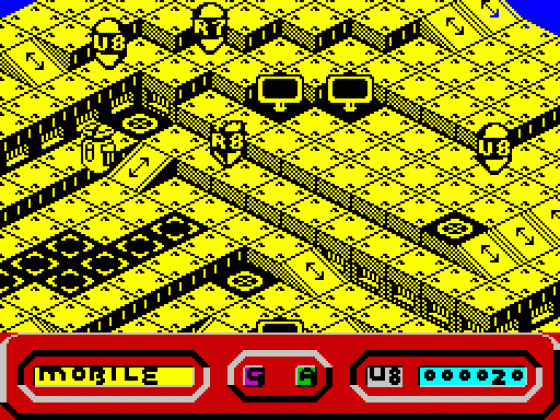Quazatron
After the success of Paradroid on the Commodore 64, Hewson have come up with a sequel - on the Spectrum! Mike Roberts grapples with this latest game.
Deep inside the planet Quartech lies the underground city of Quazatron. A Paradroid assault team was sent in - but was wiped out, the droid influencing device was ineffective; however, information received during the final report from the team resulted in the development of a close quarters grapple unit.
Where a whole paradroid squad failed, can one droid succeed? This is up to you to find out. As KLP 2, you must destroy all the robots in the robot city and cause it to power down.
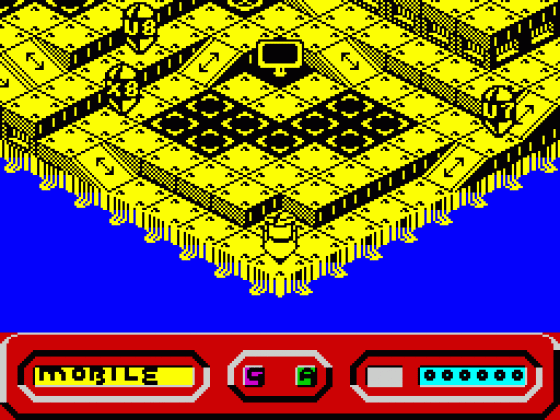
The city is on various levels - connected by lifts - each level has a number of lifts, whch will connect with a different set of levels.
The levels are populated with many different types of robot at different levels of sophistication and with different jobs. These are indicated on the front of them by an identification letter and a number. The number ranges from 1 to 9 where 1 is the most sophisticated.
Their job varies: medical, menial, battle, security, repair, programmer, control, etc are all featured. Some of these jobs are unrated. Medical and Programmer droids have no numbers. Each robot also has a security code - but more of that later.
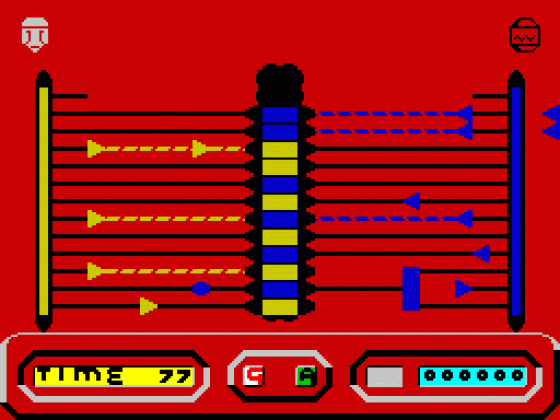
Each robot carries certain types of equipment. A drive unit, a power cell, a weapon, a chassis, and perhaps an auxilliary device that can vary in effect. Usually it is a shield, detector or booster of some kind.
Varying types of robot have different levels of equipment. Drives can be move reliable, weapons more powerful, chassis toughter, and power cells (the most important item) are prone to wearing out and need changing often. The special auxilliary items also vary according to level.
To obtain all this extra equipment you have to 'grapple' with the enemy robot. For those people who have played Paradroid, this will be a familiar exercise as it is similar to using the influencing device. What happens is that you switch to grapple mode and ram an opposing robot. You then gain access to its security circuit. With this you get a picture of a chip on the screen. On either side of this chip is a number of PCB tracks with various joins, pulsers, inverters and splitters on it. Both you and the robot have a number of 'pulsers' on whatever side of the screen that you have selected. Depending on your, and your opponent's relative level, you will have more or less pulsers than your opponent. The idea behind this section of the game is to take over your opponent by changing by majority of the cells in the central chip. To do this you move your pulsers up and down the PCB tracks. Firing will inject a current of your colour. Depending on the order that you do it in, the pattern of the tracks, the pattern of the modifiers on the tracks, and your particular strategy against the computer.
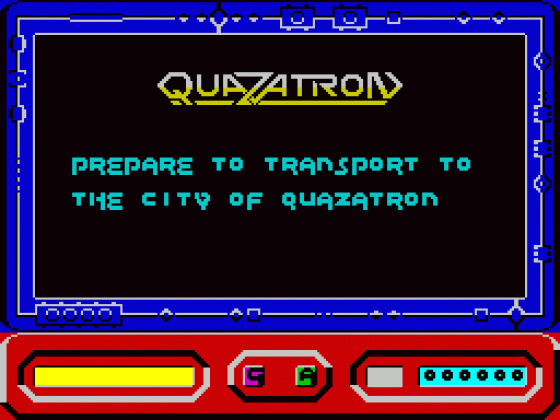
With a bit of luck - and an awful lot of thought - you will turn seven or above of the available twelve cells to your colour. If so, then you will have your choice of the parts from the robot. You don't have to have all of the parts, in fact, some of the parts may be detrimental to your current configuration. Of course, if an exceptionally powerful piece of equipment is causing you to drain your power too fast then you could always downgrade. It is also in this section that your performance in the grapple is recalled. Depending on how overwhelming your victory is, the equipment will either be interfaced directly or damaged. With a 12-0 win everything can be interfaced. However, with a 7-5 narrow squeak, you can expect most of the equipment to be faulty.
Other things that you will encounter in the game apart from lifts are power points - these are squares that will re-energize your droid, providing his power pack is up to it and providing the power point is willing to give him power. Power levels are indicated by the expression on the droid's face (smiling = lots of power, frowning = about to expire), and the speed at which his 'hat' rotates.
These points are also useful if you are attacking one of the alien robots. Normally losing the battle of wits that goes with a grapple results in your demise. But, if you are on a power point (and you are able to charge up) you will stay alive. This also goes for ramming robots and jumping on low power.
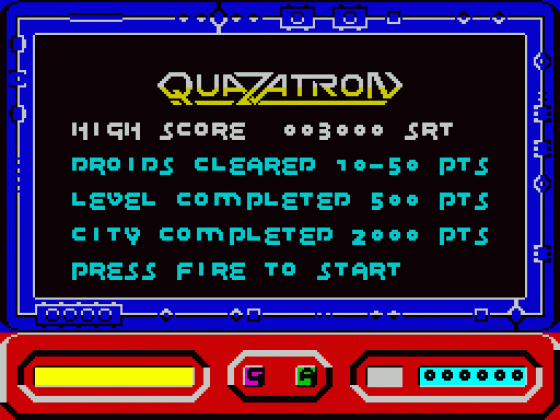
The other things that you will find are computer terminals; these let you examine the lift system, give an overall map of the level that you are on, and examine details of equipment. This is where the security code business comes in. When you successfully grapple a droid, you effectively take over it's status and security code. The status level is significant in the grapple sequence as mentioned earlier and detailed below. The security code, however, is more useful as it allows the user to access information regarding the parts that you are likely to get from scavenging enemy droids. The problem comes with the codes, as you can only access that information that is rated at the same level as you or lower. And as you are generally scavenging above, rather than below, your current level it gets a bit frustrating. however the information is gleaned, it's helpful when digging power packs out of lower class droids (it ends up like a 'Which Powerpack' review, comparing different input and output rates and general features.
The playfield itself is based around an isometric 3D-ish moving map. This bears a passing resemblance to Spindizzy, which itself is more than slightly influenced by the current crop of madness-type games. The area that you see on-screen appears to be one section of a 3 x 3 area. You jump from area to area by touching the side of the screen. The whole thing then slowly scrolls over. This is better than the more common screen-to-screen format, which can disorientate you something rotten. At least with this, you can assimilate the new screen as it appears.
Each level can be on different levels (if you know what I mean), with ramps between them. Small ledges can be jumped off with a small reduction in power. Larger ledges tend to kill you, and on a number of sections, it is impossible to move between levels. To do this, you must use a lift, cross over to the other side of another level, and then come up another lift. The alternative is to stack yourself up with bags of power and then jump off; if you land near to a power cell you might be able to make it if the ledge is not that high - I never have, but I'm sure that it's possible.
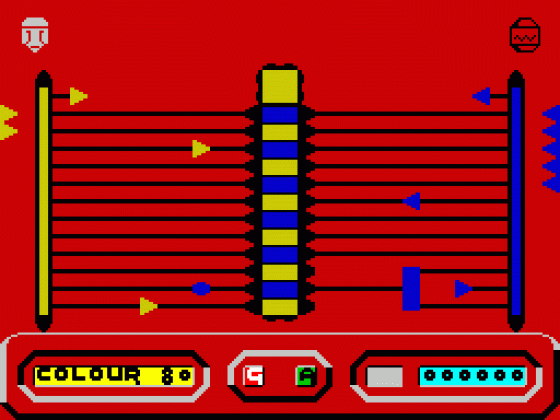
When trying to build up your defences, it is wise to start at the bottom and work upwards. Your level dictates the number of pulsers that you will start with. If you are a high level and are wiping out lower level droids, then this is a lot safer than shooting droids. Shooting droids uses up energy, but grapping with them only uses up time.
The higher grades of robot can be taken out with your weapon, though the more heavily defended droids need some care. When using the lower-powered weaponry, aiming can be a problem due to, say, the narrowness of the laser. To use one of these lower grade weapons, it means positioning yourself with a bit more precision when cornering. Why? Well, it means that you can orientate yourself with the dead centre of a square. You can go anywhere on a square, but the droids can only travel along the dead centres of squares. So if you are not lined up well enough, you might as well not bother as the laser bolts will whizz by.
Using the more advance weaponry like the auto-cannon (my personal favourite) seems to be a bit easier, though your power levels seem to be reduced at high speed, another note is to never use the autofire option - this wastes power like it was going out of fashion!
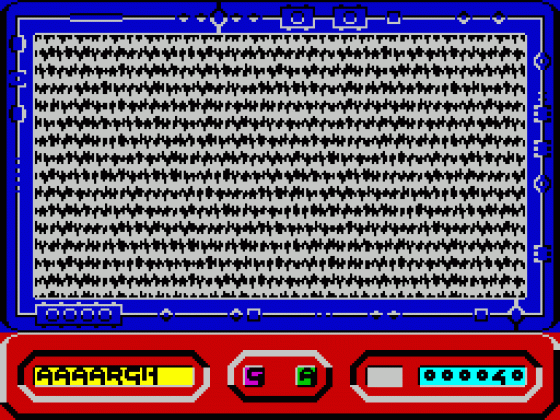
Note: Side note (bug) if you die with autofire selected, you will restart with it selected - usually the result is an early demise due to the energy drain.
Weaponry is also level-dependent. That's why I like the autocannon - it can knock out almost anythng, and is ever so much fun to use.
Grappling
Grappling technique is one of personal preference - so here's mine. Use your initial minute or so to pick which side you are going to take. Pick the one with the most pluses and the least minuses. Plus points are the lines that have the bits on them that improve your chances such as splitters (one to two or three), repeaters that will keep your signal going until long after your original pulse has faded, cells that don't have lines from the enemy side of the screen attached to them, lines that have inverters (on the opposite side of the screen). Minuses are terminators (i.e. a line that never gets to the cell), splitters (i.e. two into one), inverters on your side, and too many pluses on the enemy side.
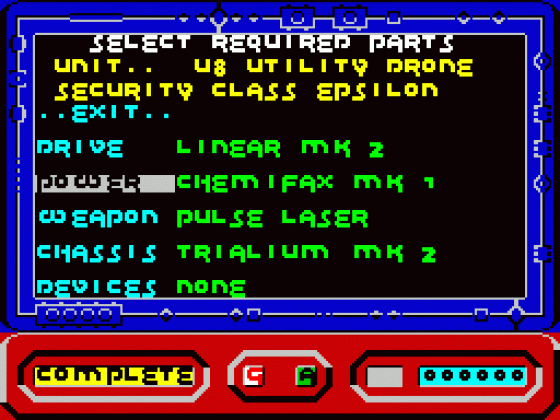
When the contest starts proper hold off, you have ninety seconds to play the game. A pulse will fade after a few seconds, so leaving off until 25 seconds before the end and then going for it is much better, because a lot of the enemy's pulses will have faded.
Then avoid all inverters, unless one is pointing at an already-lost cell, and is part of a splitter, go for all repeaters; these count heavily in your favour at the end. Obviously, terminators have to be avoided. Avoid enemy lines with terminators on them - it's a waste of pulsers. If an enemy pulse goes onto an enemy line that is contestable (i.e. nothing of any great interest on it) pulse onto it, but just after the enemy. That means that, when his pulse fades yours will still be in evidence and will win the cell.
To conclude, Quazatron is a truly excellent game. It has enough interest to sustain any games player from the simple Ladders and Platforms addict (well, there are some platforms in this), to the ardent action freak (plenty of action in this), and the strategy gamer (anyone who things that grappling is a piece of cake needs seeing to).
Excellent job Hewson, let's have more of the same.


 1st June 1986
1st June 1986
